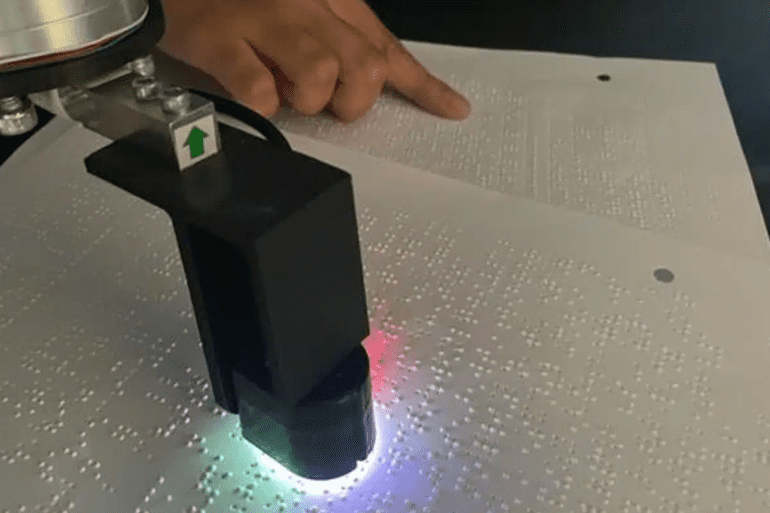TL;DR:
- University of Cambridge researchers developed an AI-powered robotic sensor that reads braille at double the speed of humans.
- Machine learning algorithms enable the robot to swiftly navigate braille text at 315 words per minute with 87% accuracy.
- This advancement, although not initially designed as assistive technology, showcases potential applications in prosthetics and robotic hands.
- Human fingertips’ sensitivity inspired the project, and researchers aim to replicate this in robots.
- The robot utilizes a camera-equipped fingertip and sophisticated algorithms to “deblur” images, allowing accurate braille reading.
- Beyond braille, this technology can be applied to tactile sensing systems for detecting surface textures or slippage in robotics.
Main AI News:
In a remarkable feat of technological advancement, researchers at the University of Cambridge have unveiled a groundbreaking robotic sensor that leverages artificial intelligence to read braille text at a pace that outpaces human abilities by twofold.
The innovative research team harnessed the power of machine learning algorithms to instruct a robotic sensor in the art of swiftly traversing lines of braille script. Astonishingly, the robot demonstrated its prowess by reading braille text at a staggering rate of 315 words per minute, achieving a commendable accuracy rate of approximately 90%.
While the primary aim of this robotic marvel wasn’t centered on assistive technology for visually impaired individuals, the researchers have unearthed an unexpected avenue of exploration. The heightened sensitivity required to decipher braille positions this technology as an ideal candidate for the development of robotic hands or prosthetics with sensitivity levels rivaling those of human fingertips.
Human fingertips, endowed with remarkable sensitivity, serve as our primary interface with the tangible world, allowing us to discern subtle variations in material textures and providing critical feedback about the amount of force required for various tasks. From handling delicate objects like eggs to more substantial ones such as bowling balls, our fingertips excel in providing the tactile information we need.
Translating this exquisite level of sensitivity into a robotic hand, all while maintaining energy efficiency, presents a formidable engineering challenge. Within the hallowed halls of Professor Fumiya Iida’s laboratory in Cambridge’s Department of Engineering, an assembly of diligent researchers is diligently tackling this and other challenges that come naturally to humans but confound our mechanical counterparts.
Parth Potdar, an undergraduate at Pembroke College and a member of Cambridge’s Department of Engineering, elucidated, “The softness of human fingertips is one of the reasons we’re able to grip things with the right amount of pressure. For robotics, softness is a useful characteristic, but you also need lots of sensor information, and it’s tricky to have both at once, especially when dealing with flexible or deformable surfaces.”
Braille serves as an ideal litmus test for a robotic ‘fingertip,’ given its demanding requirement for high sensitivity. The minuscule dots constituting each letter in braille are densely packed, posing a formidable challenge for robotic sensors. The researchers ingeniously employed an off-the-shelf sensor to craft a robotic braille reader that faithfully emulates human reading behavior.
David Hardman, another co-author from the Department of Engineering, underscored the limitations of existing robotic braille readers: “Existing robotic braille readers work in a static way: they touch one letter pattern, read it, pull up from the surface, move over, lower onto the next letter pattern, and so on. We want something that’s more realistic and far more efficient.”
The robotic sensor, central to this technological marvel, is equipped with a camera in its ‘fingertip,’ utilizing a fusion of visual data from the camera and input from sensors. Potdar emphasized, “This is a hard problem for roboticists as there’s a lot of image processing that needs to be done to remove motion blur, which is time and energy-consuming.”
The team overcame this hurdle by developing sophisticated machine learning algorithms that enabled the robotic reader to effectively ‘deblur’ images before embarking on the letter recognition process. They trained the algorithm using sharp images of braille with artificial blur applied, allowing it to master the art of deblurring the letters. Subsequently, a computer vision model was employed to detect and classify each character.
With the incorporation of these cutting-edge algorithms, the researchers conducted a series of tests, propelling the robotic braille reader along rows of braille characters at remarkable speeds. The results were nothing short of astonishing, as the robotic counterpart achieved a reading speed of 315 words per minute with an impressive accuracy rate of 87%, surpassing the capabilities of a human braille reader by twofold.
David Hardman marveled at the achievement, noting, “Considering that we used fake blur to train the algorithm, it was surprising how accurate it was at reading braille. We found a nice trade-off between speed and accuracy, which is also the case with human readers.”
Furthermore, this breakthrough technology isn’t confined solely to the realm of braille. The researchers believe that the ability to gauge braille reading speed serves as a valuable yardstick for assessing the dynamic performance of tactile sensing systems. Consequently, the potential applications extend beyond braille, encompassing tasks such as detecting surface textures or slippage in robotic manipulation.
In the grand scheme of things, the researchers harbor ambitious plans to upscale this technology to the size of a humanoid hand or even the sensitive skin of a robot, further expanding the horizons of what is achievable in the realm of tactile robotics.
Conclusion:
The development of this AI-powered robotic sensor represents a significant leap in the field of tactile robotics. Its ability to read braille text at double the speed of humans while maintaining high accuracy opens up promising opportunities for advanced prosthetics, robotic hands, and enhanced tactile sensing systems. This breakthrough has the potential to revolutionize various industries, making robots more adept at handling delicate tasks and interacting with the world around them.

